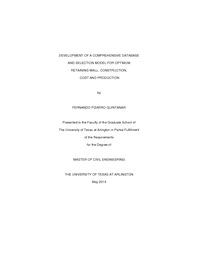
ATTENTION: The works hosted here are being migrated to a new repository that will consolidate resources, improve discoverability, and better show UTA's research impact on the global community. We will update authors as the migration progresses. Please see MavMatrix for more information.
Show simple item record
| dc.contributor.author | Pizarro Quintanar, Fernando | en_US |
| dc.date.accessioned | 2014-07-14T20:20:51Z | |
| dc.date.available | 2014-07-14T20:20:51Z | |
| dc.date.issued | 2014-07-14 | |
| dc.date.submitted | January 2014 | en_US |
| dc.identifier.other | DISS-12605 | en_US |
| dc.identifier.uri | http://hdl.handle.net/10106/24385 | |
| dc.description.abstract | Retaining walls are earth retention elements that result essential in the majority of the construction projects for the overall project performance, as well as its budget and schedule. These elements constitute a key role in urban development, industrial facilities and civil projects as evidenced by the more than 170 million of square feet being constructed per year in the United States. The current market conditions, as well as the advances in the technology and knowledge associated to these elements, determine the need for accurate decision making processes that lead to optimum retaining walls in terms of applicability, cost and production rates.More than 50 types of retaining walls are currently available in the market, having each one of them further subdivision depending on the materials and configurations being used. Thus, properly developed databases and decision models are highly important to make accurate selections. Each type of retaining wall present a unique set of advantages and disadvantages, construction processes, equipment and material needs as well as limitations. These particular features of each are identified and analyzed in order to determine those factors driving the selection of each type. Successful experiences in previous projects do not ensure proper outcomes in the future ones and therefore only a project specific analysis can provide the basis for the reduction of the risk associated with the wall selection. This research analyzes and present those considerations that determine the adequacy of each type of wall and the factors that affect their performance during and after construction.Literature references in retaining wall design and construction are extensive and complete. However, no single source provides a comprehensive guideline for the analysis of the different types of retaining walls in order to make a comparative analysis that can lead to a selection decision. This lack of references is greater in regards to unit costs, production rates and construction issues mostly caused by the commercial implications of disclosing them. Specialized references consider the field observation and record keeping as the most adequate approach to determine accurate unit costs and production rates. The results from the literature review, analysis of previous experiences, surveys and interviews to expert subjects are supplemented with field observations of heavy civil construction Projects in the DFW area to determine typical unit costs, production rates and construction issues. While the identified construction issues can serve as the base for the developments of specially tailored QA/QC programs, the unit costs and production rates can be used as a database for future preliminary studies and are built into the decision model developed in this research.Previous studies have attempted to develop wall selection models that use previous experiences to determine the most appropriate retaining wall type for a specific set of needs and constraints. However, these references failed to include three key factors such as direction of construction, unit cost and production rates. The selection model developed in this research follows an Imperialist Competitive Algorithm (ICA), based on a knowledge database and incorporating specific decision driving parameters for each wall type. The model is validated using four known walls as input in order to compare the solutions returned by the model against the real-world constructed ones. Additionally, subject experts are used to further validate the accuracy of the model to replicate expert reasoning process. The data obtained during the different collection phases, as well as the analyses performed can serve as a starting point for future preliminary studies. The selection model developed ins this research can be used to determine the most adequate retaining wall for a specific set of constraints, where limited information is available. | en_US |
| dc.description.sponsorship | Najafi, Mohammad | en_US |
| dc.language.iso | en | en_US |
| dc.publisher | Civil & Environmental Engineering | en_US |
| dc.title | Development Of A Database And Selection Model For Optimum Retaining Wall Construction, Cost And Production | en_US |
| dc.type | M.S. | en_US |
| dc.contributor.committeeChair | Najafi, Mohammad | en_US |
| dc.degree.department | Civil & Environmental Engineering | en_US |
| dc.degree.discipline | Civil & Environmental Engineering | en_US |
| dc.degree.grantor | University of Texas at Arlington | en_US |
| dc.degree.level | masters | en_US |
| dc.degree.name | M.S. | en_US |
Files in this item
- Name:
- PIZARROQUINTANAR_uta_2502M_126 ...
- Size:
- 4.516Mb
- Format:
- PDF
This item appears in the following Collection(s)
Show simple item record


